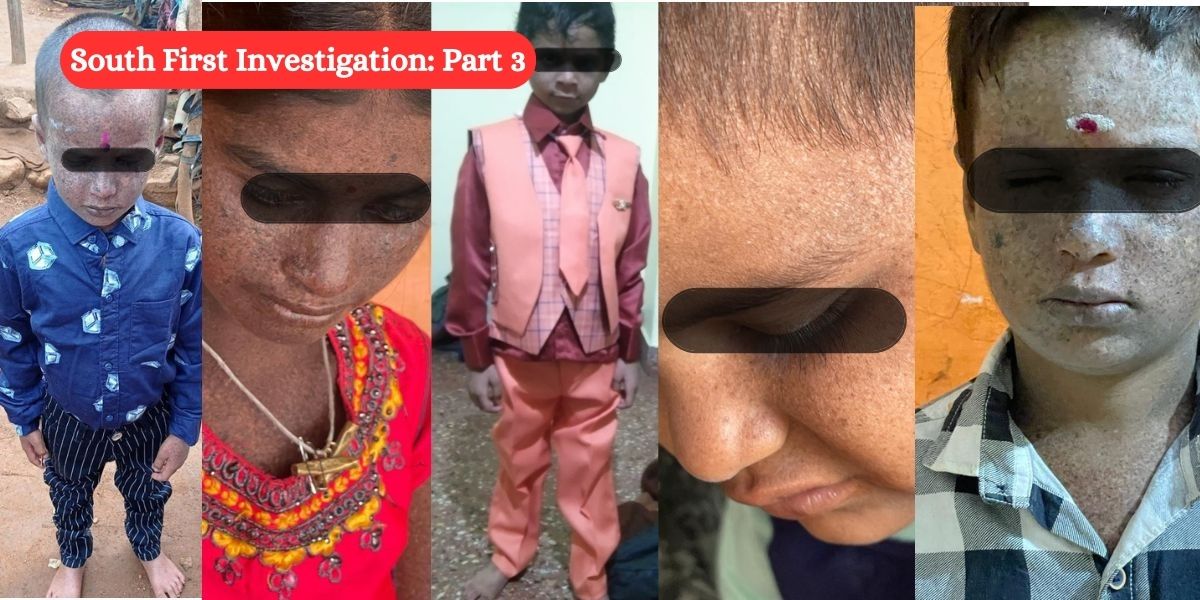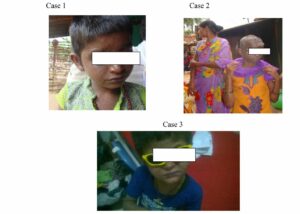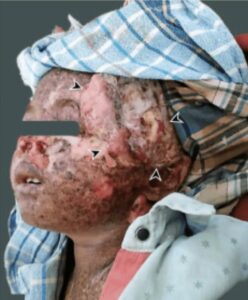Xeroderma Pigmentosum has been claiming lives of children in Kuratti Hosur, Bhadrenahalli and Shettalli. More are struggling to stay afloat without medical assistance.

Images of the children affected.
This is the third and concluding part of an investigative report on Xeroderma Pigmentosum, a genetic condition characterised by extreme sun sensitivity. Several children of three villages in Karnataka’s Chamarajanagar are forced to sequester themselves indoors for an additional lease of life, which the villagers firmly believe, won’t go beyond 18 years. Their belief is based on experience, and hence they are not seeking medical assistance. The children are left to die a miserable death. Read part one and part two.
The souls of darkness come alive as night throws a blanket over the three villages, Kuratti Hosuru, Bhadrenahalli, and Shettalli.
The moonlight has a soothing effect on the Xeroderma Pigmentosum (XP)-affected, giving them the confidence to step out of the confines of their homes and take in lungsful of fresh air.
“They are the moonwalkers. They should step out only when the moon is up. If they manage their condition with high SPF (sun protection factor) creams, body lotions, full-sleeved dresses, hats, gloves, socks, etc, they can prolong their life,” Dr Deepa Bhat, Genetic Counsellor of JSS Medical College and Hospital in Mysuru, said.
However, even at night children like Savitha of Kuratti Hosuru cannot soak in the beauty of the world around them, the silhouetting Male Mahadeshwara Hills remains a lingering visual that she had before XP affected her vision.
Those who can see have visited the children a few times. They spoke to them, their parents, and villagers made notes, clicked photographs, and left. The villagers are not happy but they still present the children before outsiders, and narrate the same tale, hoping for a brighter tomorrow for the kids.
The villagers said the researchers came from various cities like Bengaluru, Mysuru, and New Delhi.
“They asked us some questions, took pictures, and videos of our children, and didn’t return to tell us what had happened or suggest any treatment options or precautions to be taken,” Savitha’s parents Lakshmi and Basavanna said. Many others concurred.
Perhaps, the researchers might have found themselves in a helpless situation, unable to do anything, except to leave the children at the mercy of the pact the sun has with death.
A 2014 research paper published in the Indian Journal of Dermatol Venereol Leprol, funded by the Genetic Research Centre, has mentioned the cases in Karnataka. “To date, 37 unrelated families with patients having XP have been reported from India. Many families have been reported from South India especially Karnataka, where significant consanguinity is observed,” it said.

Pic of three kids from Munimadashetty’s family who died due to Xeroderma Pigmentosum in Kuratti Hosuru. (Supplied)
The paper, Clinical Profile and Mutation Analysis of Xeroderma Pigmentosum in Indian Patients recommended the screening of Indian patients with neurological symptoms for mutations in the XPA gene. “Rapid molecular diagnosis would aid definitive diagnosis, genetic counselling, and prenatal diagnosis,“ the paper said.
In 2016, three researchers found that four patients from Kuratti-Hosuru village were treated for two weeks at the Government Ayurveda Medical College and Hospital in Mysuru.
They visited the village, collected information from the families of the affected children, including retired teacher Munimadashetty, and published a report in the International Ayurvedic Medical Journal (IAMJ).
The report cited the case of a 16-year-old girl, who had spots on all over her body, totally blind and suffering from loss of hair. Her case was not directly linked to consanguine marriage.
Another case mentioned was of a three-year-old boy, who could not open his eyes to the light. He exhibited abnormal skin features on the face. They also studied another boy, aged two. All three had lesions all over the face including the head. None of them are now alive.
The researchers diagnosed the condition as XP. The report concluded that the average lifespan of the affected is limited to 15 years. It offered no solution, except total protection from sunlight (with dark glasses and clothing). No effective medication was reported.
While several families are not seeking medical help for their children, a few — hoping against hope — tried Ayurveda.
“I tried Ayurveda medicines from Dr Giridhara Kaje for almost two years but it did not help Heishika,” the four-year-old girl’s father Praveen Kumar said. He is trying to understand the rare disease and find a way to at least prevent the condition from worsening.
Savitha, too, was taken to the Ayurveda Medical College in Mysuru. “We take her to the hospital every three months. They give us the extracts of some leaves to be applied to her eyes. It helps in reducing the boils,” Basavanna said. The girl will be celebrating — or mourning — her 14th birthday in August. “A year closer to death,” as her mother Lakshmi puts it.
The IAMJ report said the researchers pored over Ayurvedic literature on skin diseases. They found that there are seven layers of the skin and the Atharva Veda has mentioned three types of skin diseases — or twak rogas: Kilata, Palita, and Nirita. It also suggested herbal remedies for these diseases.
However, the researchers reported that it is difficult to clearly diagnose the conditions in practical terms and to provide possible English identifications for those diseases. The report also highlighted the inadequate research on such diseases and the lack of awareness about them.
The researchers also termed it “tragic” that no medical researcher had looked into the disease for which a cure is considered asadhya, or impossible, by the previous generation.
They said it is scientifically important to undertake such research efforts. South First’s visit to these villages revealed that no serious research has been taken up nor has any efforts been made to create awareness among the villagers. They are still groping in the dark for answers.
Xeroderma Pigmentosa (XP) is an extremely rare autosomal recessive genetic disorder, affecting roughly one in a million individuals globally.

Representative pic of a child with similar condition presented in Hubballi on how bad the condition could get. (Supplied)
Explaining the condition, Dr Bhat, who works with rare diseases and sickle-cell anaemia patients, said individuals with Xeroderma Pigmentosum cannot effectively repair DNA damage caused by exposure to ultraviolet radiation.
“As a result, even brief exposure to sunlight can lead to sunburns, freckling, and other skin changes. Over some time, repeated exposure to ultraviolet rays can cause significant damage to the skin, including premature aging, dryness (xeroderma), and pigment changes,” she told South First.
Dr Bhat added that one of the most concerning aspects of XP is the high risk of developing skin cancers, particularly basal cell carcinoma, squamous cell carcinoma, and melanoma.
Dermatologist Dr Srishti Betsurmath has seen two cases from these villages while working with the JSS Medical College earlier.
She explained that XP has eight genotypes. Each one has a different clinical presentation. A common feature is rashes. They usually have blackish hyper-pigmented patches on areas exposed to the sun.
A few of them affect the eye — the cornea, conjunctiva, and eyelids. They will have keratitis (inflammation of the cornea), photophobia, extreme photosensitive skin and eyes. A few patients show central nervous system manifestations like intellectual disability, etc. Each complementation group exhibits different symptoms.
“It all depends on their duration of exposure to the sun and other factors. If the patient has photosensitivity, skin irritation, later a cumulative damage to the skin, they are prone to have melanoma, non-melanoma skin cancers, and other related cancers.” Dr Betsurmath told South First.
“Not just the skin, they can even have cancers of the oral cavity,” she added while advising patients to avoid exposure to sunlight by staying indoors during daylight hours or wearing protective clothing and sunscreen with high sun protection factor when stepping out.
The rarity of the disorder and its serious consequences make it a challenging and lifelong condition. “As of now, there is no cure for Xeroderma Pigmentosum, and its management primarily revolves around sun protection measures and regular monitoring of the skin for changes and cancers,” Dr Bhat added.
XP is an autosomal recessive disorder, meaning that an individual must inherit two mutated copies of the responsible gene (one from each parent) to develop the condition.
Dr Bhat opined that XP is in the genes of these three villages. She further explained the possible reasons for the cases confining to the Banajiga Shetty community which has most afflicted children.
“It appears that segregation might have occurred in this community due to several generations of endogamy. Historically, individuals within the community tended to marry within their group, possibly leading to a higher prevalence of an autosomal recessive disorder,” she reasoned.
When the carriers of the disorder marry, their child has a 25 percent chance of inheriting the condition. “It may not be limited to one child. Multiple children may be affected,” the doctor said.
“If only the bride is a carrier, then the child will not get this condition. However, there will be a 25 percent chance of the girl becoming a carrier. The chances of her becoming a carrier come down with generations. If the government intervenes now, the condition can be prevented in the next 25-30 years,” Dr Bhat added.
Though the endogamous trend is gradually changing, it will take some time to completely root out this practice. To address the issue, genetic testing is crucial for the entire community to determine carrier status and assess the risk of passing the disorder down to future generations.
Those planning to marry within the community should undergo genetic testing to identify if they are carriers of the disorder. If one of them is found to be a carrier, it may raise concerns about issues later.
Dr Bhat emphasised the significance of genetic counselling for families with a history of XP, since it will enable them to better understand the risk of passing the condition down to their children.
“Awareness about this condition is essential, and it is only through sharing information that people become aware of the segregation of this particular community,” she said.
The villagers, however, are not willing to accept that consanguine marriages are causing XP. They want proper research-based evidence.
The villagers said consanguine marriages have been the norm for generations. “If we don’t marry within blood relations, our relatives will feel bad. Nowadays, after several people are facing such conditions, some are marrying girls from other villages but even their children are getting such diseases,” they pointed out.
“I married my sister’s daughter. Our one child had the condition but not the other two. Now, my second daughter is not alive but the first and the third ones are doing good. They also married within the family, and have children with no condition,” Muddumadashetty, another villager who lost his daughter Ayamma four years ago, told South First.
Doctors Betsurmath and Bhat stressed the need to create awareness in the community besides making them undergo genetic testing to identify carriers and manage potential health risks.
The situation in the three villages has not caught the attention of either the public health centres or the district hospital.
“It’s unfortunate,” Dr Bhat said. She demanded that the issue should be addressed at the national level. “Certain genetic traits may persist across generations within specific communities and if genetic counselling is not provided, then the number of people with this condition will increase,” the doctor explained.
Dr Bhat kept reiterating the need for counselling and genetic testing. The government must ensure that the entire community undergoes genetic testing. The government should provide the tests at subsidised rates,” she said.
It is easier said than done. Even the Health Department is unaware of XP. Health officials should be made aware of the dire necessity of diagnosing and reporting this condition.
Dr Bhat added that by checking the community members’ carrier status, individuals can be aware of potential risks and make informed decisions, especially if two people from the same community plan to marry. Identifying carriers before marriage can help address potential issues that may arise in the future.
Genetic counseling is especially crucial for families with a history of XP, enabling them to fully grasp the risk of passing the condition to their children.
The prevalence of consanguineous marriages in India has contributed to around 450 rare diseases. It highlights the need for raising awareness and facilitating access to genetic testing and counselling services to address the impact of genetic disorders within the population.
Calling it unfortunate that little research has been conducted in these villages, and the impact of environmental factors on gene expression, Dr Bhat said higher ultraviolet rays in certain areas might be crucial in effectively understanding and managing XP.
“It is the responsibility of local, regional, and national health departments to address public health issues, especially when they involve rare and life-altering conditions like XP. Immediate action is warranted to provide these children and their families with the support they desperately need,” she further said.
The health authorities must initiate awareness and education campaigns to inform the public about XP. This includes highlighting the early symptoms, the importance of diagnosis, and the availability of medical care options.
Meanwhile, authorities should ensure the availability of medical services and expert consultations, specialised medical services, and consultations with dermatologists, geneticists, and oncologists. “Providing support groups and counselling for their emotional well-being is equally vital,” Dr Bhat said.
Dr Betsurmath and Dr Bhat said collaborating with research institutions and genetic experts can help better understand the genetic basis of the cluster of XP cases in these villages. It can also pave the way for targeted interventions and preventive measures.
Meanwhile, government bodies should allocate resources and funding to address the specific healthcare needs of these children. This includes setting up healthcare facilities and ensuring the availability of essential medications and protective equipment.
Even then, as Dr Bhat said, the condition can be prevented only in the next 25-30 years. Meanwhile, the affected children in the three villages will remain helpless in dark confinement. The only assurance they have is a premature death.
(Concluding part of a three-report investigative series on Xeroderma Pigmentosum-afflicted children: Patients have been identified, hoping they get the assistance they need.)

May 19, 2024

May 19, 2024

May 19, 2024

May 19, 2024

May 19, 2024

May 18, 2024